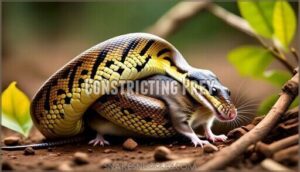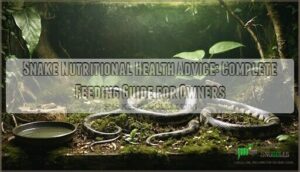This site is supported by our readers. We may earn a commission, at no cost to you, if you purchase through links.
 Healthy snake eating habits revolve around feeding whole prey that mirrors their natural diet.
Healthy snake eating habits revolve around feeding whole prey that mirrors their natural diet.
You’ll want to offer frozen-thawed rodents, which provide complete nutrition including the ideal 2:1 calcium-phosphorus ratio your snake needs.
Feed prey that matches your snake’s thickest body section—too large causes regurgitation, too small leaves them hungry.
Most adult snakes eat every 7-14 days, while juveniles need weekly meals.
Skip live feeding; it’s dangerous and unnecessary.
Whole prey delivers everything from organs to bones, eliminating guesswork about supplements.
Your snake’s species matters too—ball pythons thrive on mice, while garter snakes need fish.
The secret lies in understanding what makes prey selection truly effective, and providing the right food is crucial for their health, with a focus on complete nutrition and the right diet.
Table Of Contents
- Key Takeaways
- Snake Eating Habits
- Healthy Snake Diets
- Snake Feeding Techniques
- Snake Dietary Management
- Snake Nutrition and Growth
- Frequently Asked Questions (FAQs)
- How to know if a snake is eating enough?
- What are the eating habits of snakes?
- How can I tell if my snake is healthy?
- How to properly feed your snake?
- How often should I weigh my pet snake?
- What temperature should snake food be served at?
- How long can snakes go without eating?
- Should I feed my snake in its enclosure?
- How often should juvenile snakes eat compared to adults?
- What signs indicate a snake is ready to eat?
- Conclusion
Key Takeaways
- Feed frozen-thawed whole prey that matches your snake’s thickest body section – this provides complete nutrition with the ideal 2:1 calcium-phosphorus ratio without the risks of live feeding
- Establish species-specific feeding schedules with adults eating every 7-14 days and juveniles weekly, as different species have unique dietary needs (ball pythons thrive on mice while garter snakes need fish)
- Monitor your snake’s weight and feeding response regularly to catch health issues early and ensure proper growth – consistent weight gain and alert behavior indicate good health
- Avoid supplements when feeding whole prey since complete animals provide all necessary vitamins, minerals, and nutrients your snake evolved to process naturally
Snake Eating Habits
Understanding your snake’s eating habits starts with proper prey selection, which directly impacts their health and longevity.
You’ll need to match prey size to your snake’s body width and establish consistent feeding schedules based on their species and age requirements.
Importance of Prey Selection
Your prey-selection choices directly impact your snake’s long-term health and vitality. Snake prey availability shapes habitat preferences, while nutrient density varies substantially between prey types.
Proper prey selection prevents deficiencies, supports growth, and maintains natural behaviors in captive snakes. Snakes benefit from a diet of whole prey for complete nutrition.
Whole prey delivers the complete nutrition your snake needs to thrive naturally
- Nutrient Density: Mice provide highest fat content (25.7%), while chicks offer superior crude protein (76.4%) for balanced snake nutrition
- Prey Diversity: Wild conservation research shows snakes consuming varied prey species prevents nutritional deficiencies and supports peak health
- Ethical Sourcing: Disease-free, healthy prey prevents parasite introduction and digestive complications in your snake’s system
- Snake Health: Species-specific prey selection replicates natural feeding patterns, ensuring proper vitamin and mineral requirements are met consistently
Whole Prey Benefits
Feeding whole prey items gives your snake complete nutrition that individual supplements can’t match.
Whole prey delivers complete nutrition that supplements simply can’t replicate for optimal snake health.
When you choose whole prey, you’re providing nutrient variety that supports digestive health and encourages natural behavior patterns.
This approach reduces supplementation needs substantially.
| Nutrient Benefit | Whole Prey | Individual Supplements |
|---|---|---|
| Complete Nutrition | All organs provide balanced vitamins | Requires multiple products |
| Natural Behavior | Mimics wild snake diet patterns | Doesn’t stimulate hunting instincts |
| Digestive Health | Bones aid proper digestion | May lack essential roughage |
| Cost Efficiency | Single purchase covers all needs | Multiple expensive supplements required |
Your snake’s body evolved to process entire animals, from muscle tissue to organs.
Frozen-thawed rodents deliver this complete package, ensuring ideal snake nutrition without guesswork.
Feeding Frequency and Size
Age considerations and species metabolism determine your snake’s feeding schedule.
Young snakes need meals every 5-7 days, while adults eat every 10-14 days.
Prey weight should match your snake’s thickest body section.
Proper meal timing prevents regurgitation risks.
Monitor feeding behavior and snake weight regularly to adjust schedules.
A helpful tool is a snake weight chart to guarantee proper growth.
Overfeeding creates health problems faster than underfeeding.
Healthy Snake Diets
Your snake’s nutritional needs go far beyond simply offering prey items.
A balanced diet requires careful attention to calcium-phosphorus ratios, vitamin D3 levels, and essential trace minerals that support everything from bone health to proper shedding.
Calcium and Phosphorus Balance
Maintaining proper calcium balance in your snake’s diet isn’t rocket science, but getting the mineral ratios right makes all the difference.
Whole prey naturally provides the ideal 2:1 calcium-phosphorus ratio, supporting bone density and preventing MBD.
Reptiles with poor diets can develop nutritional secondary hyperparathyroidism, a common skeletal disease.
- Bone Density: Whole prey with bones delivers natural calcium without supplementation needs
- Mineral Ratios: Aim for 2:1 calcium-phosphorus balance to prevent metabolic bone disease
- MBD Prevention: Excess phosphorus blocks calcium absorption, causing soft bones
- Dietary Sources: Rodents, birds, and other vertebrate prey provide ideal calcium balance
- Supplementation Needs: Rarely necessary when feeding appropriate whole prey items regularly
Vitamin D3 Role
Vitamin D3 acts like your snake’s internal light switch for calcium absorption. Without proper UVB lighting or vitamin D3 supplements, your pet can’t process calcium effectively, leading to serious bone health problems.
D3 synthesis occurs naturally through UV exposure, but captive snakes often need supplementation. A vital element is phosphorus for absorption of calcium in the body.
However, overdosing creates toxicity risks, so balance matters most.
Trace Minerals Importance
Three trace minerals work like a well-oiled machine in your snake’s body.
Iron supports oxygen transport, while zinc promotes skin health and wound healing.
Copper aids enzyme activation and immune support.
These minerals come from whole prey’s organs and bones, making complete nutrition essential.
Quality snake supplements can fill gaps, but natural mineral sources through proper snake dietary needs remain best for ideal snake health.
Snake Feeding Techniques
You’ll see three main feeding techniques when watching snakes hunt and eat their prey.
These natural methods – constricting, envenomation, and ambush tactics – shape how you should approach feeding your pet snake safely.
Constricting Prey
Powerful constrictors like boas and pythons use their muscular strength to squeeze prey until suffocation occurs.
You’ll notice these snakes coil around rodents, applying pressure that stops blood flow rather than crushing bones.
This constriction mechanics evolved as an efficient hunting strategy, allowing snakes to consume prey larger than their head.
The suffocation process typically takes minutes, making frozen-thawed prey safer for captive snakes than live feeding.
Many owners opt for convenient frozen options for their snakes.
Venomous Snake Feeding
While venomous snakes inject toxins to immobilize prey, you’ll never handle live prey with venomous species in captivity.
Snake venom delivery systems evolved for hunting, not feeding safety in terrariums. Venom toxicity begins the digestion process internally, breaking down tissues before swallowing.
Many owners choose to use frozen rodents for their snakes. Professional snake feeding protocols eliminate live prey risks, ensuring your venomous snake receives proper nutrition without dangerous encounters.
Ambush Predator Tactics
Ambush predators perfect the art of patience, waiting motionless for unsuspecting prey to wander within striking distance.
These sit-and-wait specialists rely on energy conservation and precise timing rather than active pursuit.
Their hunting strategies include:
- Camouflage strategies – Blending seamlessly with rocks, leaves, or sand to become invisible
- Sensory perception – Using heat-sensing pits and vibration detection to locate approaching prey
- Strike speed – Releasing lightning-fast attacks when prey enters their kill zone
This snake behavior maximizes hunting success while minimizing energy expenditure.
Snakes use disruptive camouflage patterns to further enhance their concealment.
Snake Dietary Management
Managing your snake’s diet properly means understanding their unique nutritional needs and feeding requirements.
You’ll need to match prey size to your snake’s body width and replicate their natural eating patterns for ideal health.
Species-Specific Diets
Understanding your snake’s dietary adaptations starts with recognizing that each species evolved alongside specific prey availability in their natural habitats.
Ball pythons thrive on rodents, while garter snakes need fish and amphibians.
These nutritional requirements can’t be ignored in captive diets.
| Snake Species | Primary Prey | Captive Diet |
|---|---|---|
| Ball Python | Small mammals | Frozen-thawed mice/rats |
| Garter Snake | Fish, amphibians | Fish, earthworms |
| Corn Snake | Rodents, birds | Mice, occasional chicks |
| King Snake | Other snakes, rodents | Mice, rats |
| Green Snake | Insects, spiders | Crickets, soft insects |
Wild conservation efforts depend on maintaining these natural feeding patterns, ensuring snake nutrition supports both individual snake health and ecosystem balance.
Prey Size and Digestion
Getting the ideal prey size right is vital—your snake’s meal should match its widest body part.
Right-sized meals digest smoothly—too big causes problems
When prey size exceeds this guideline, digestion rates slow dramatically, creating undigested food that can cause regurgitation.
Proper sizing guarantees efficient nutrient absorption and prevents digestive complications that stress your pet’s system, ensuring a healthy pet through proper care.
Replicating Natural Diets
Mimicking Wild Prey Variety in captivity guarantees your snake receives balanced nutrition that mirrors its natural habitat.
Research your species’ habitat diet impact, then source prey ethically to match their natural feeding behaviors.
This conservation diet link supports proper snake nutritional requirements while honoring their evolved snake dietary preferences and feeding habits.
Snake Nutrition and Growth
Your snake’s nutrition directly impacts its growth rate, muscle development, and overall health throughout its lifetime.
Monitoring weight changes and feeding patterns helps you catch potential health issues early, ensuring your pet thrives with proper dietary management.
Balanced Nutrition Importance
Proper snake nutrition isn’t just about filling your pet’s belly—it’s about building a foundation for lifelong health.
You’ll want to focus on balanced nutrition that prevents nutrient deficiencies and supports long-term wellness.
A balanced diet guarantees peak health through:
- Prey quality that matches your snake’s natural dietary needs
- Complete nutrition from whole prey items, not supplements alone
- Consistent feeding that prevents vitamin deficiencies and maintains energy.
Snakes also require a proper calcium ratio to maintain bone health.
Growth and Weight Monitoring
Tracking your snake’s progress isn’t just about numbers—it’s about spotting patterns that tell you everything’s working perfectly.
Regular weighing reveals snake weight fluctuations that might signal health changes before they become serious problems.
Record keeping becomes your roadmap to understanding your pet’s unique patterns.
| Monitoring Method | Frequency | Key Benefits |
|---|---|---|
| Weight Tracking | Weekly | Detects snake growth rates, identifies concerning fluctuations |
| Body Condition Scoring | Monthly | Assesses overall health, prevents obesity or underweight issues |
| Growth Rate Charts | Ongoing | Tracks development patterns, guides feeding adjustments |
Weight Fluctuation Analysis helps you understand normal variations versus concerning drops.
Shedding Cycle Impact affects snake body mass temporarily, so don’t panic if numbers dip during molting.
Hydration Level Effects also influence readings—a well-hydrated snake weighs more than a dehydrated one.
Preventing Metabolic Bone Disease
You can prevent metabolic bone disease by maintaining proper calcium ratios of 2:1 with phosphorus in your snake’s diet.
D3 supplementation becomes necessary when UVB lighting isn’t available, as vitamin D3 helps calcium absorption.
Diet variety through whole prey provides natural minerals that support bone density, while nutritional deficiencies from poor feeding practices directly cause this preventable condition.
Radiographs can help reveal bone density changes during diagnosis.
Frequently Asked Questions (FAQs)
How to know if a snake is eating enough?
Don’t put all your eggs in one basket when monitoring snake health.
You’ll know your snake’s eating enough by tracking consistent weight gain, regular feeding schedules, and maintaining proper body condition where ribs aren’t visible.
What are the eating habits of snakes?
Snakes are strict carnivores that eat whole prey like rodents, birds, and insects.
They’re ambush predators or active hunters, using constriction or venom to capture meals, with feeding frequency varying by species and age.
How can I tell if my snake is healthy?
Like a window to your snake’s soul, clear, bright eyes and smooth, shiny skin reveal good health.
You’ll notice regular eating, stable weight, consistent shedding cycles, and alert, active behavior patterns indicating your serpent’s thriving.
How to properly feed your snake?
Feed your snake appropriately sized frozen-thawed prey every 1-2 weeks for adults, weekly for juveniles.
Match prey width to snake’s thickest body section.
Monitor eating habits and weight regularly for peak health.
How often should I weigh my pet snake?
Like a gardener who checks their prized roses weekly, you’ll want to weigh your snake regularly to catch problems early.
Monthly weighing works perfectly for adult snakes, while juveniles need weekly check-ins during their rapid growth phases, and it’s essential to weigh them regularly to monitor their health and growth.
What temperature should snake food be served at?
Room temperature or slightly warm prey works best for your snake’s digestion. You’ll want the food around 80-90°F, which mimics natural body temperature and triggers feeding responses effectively.
How long can snakes go without eating?
Adult snakes can survive weeks to months without eating, depending on species, age, and health.
Young snakes need food more frequently.
You’ll notice weight loss and behavioral changes if your snake isn’t eating regularly.
Should I feed my snake in its enclosure?
Yes, you should feed your snake in its enclosure. Moving snakes during feeding can cause stress and regurgitation. Feeding in their home environment feels safer and more natural for them.
How often should juvenile snakes eat compared to adults?
Juvenile snakes need frequent meals every 5-7 days while adults eat every 10-14 days. Young snakes burn energy rapidly for growth, requiring more calories than mature snakes with slower metabolisms.
What signs indicate a snake is ready to eat?
Unlike your pet dog who practically inhales kibble, you’ll notice your snake becomes a calculated predator when hunger strikes.
Watch for increased activity, tongue-flicking, restless movement, and alert positioning near feeding areas—clear signals your serpent’s ready to hunt.
Conclusion
What separates thriving snakes from struggling ones? Understanding healthy snake eating habits makes all the difference.
You’ve learned that frozen-thawed prey provides complete nutrition, proper sizing prevents health issues, and species-specific diets promote healthy growth.
Remember the 2:1 calcium-phosphorus ratio, feed appropriate portions every 7-14 days, and avoid live prey risks.
Monitor your snake’s weight and feeding response regularly. These fundamentals create the foundation for your pet’s long-term health and well-being.
- https://community.morphmarket.com/t/regarding-how-snakes-digest-their-food-and-what-s-healthiest-for-them-in-captivity/39559
- https://talis-us.com/blogs/news/5-nutritional-requirements-for-a-healthy-snake-pet-diet
- https://www.chewy.com/education/reptile-and-amphibian/snake/what-do-snakes-eat
- https://www.reddit.com/r/snakes/comments/18idcpi/what_pet_snakes_dont_eat_mice/
- https://www.merckvetmanual.com/management-and-nutrition/nutrition-exotic-and-zoo-animals/nutrition-in-snakes














